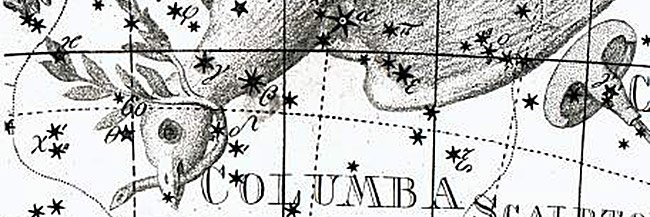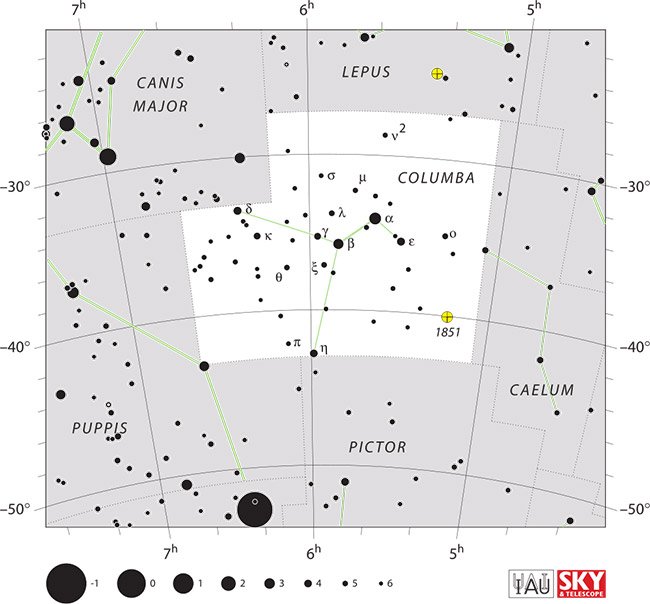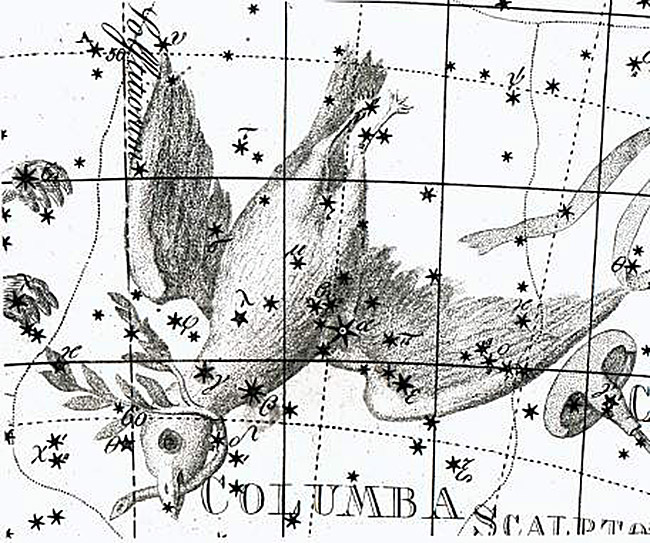Columba – Constellation Facts

Columba derives its name from Latin meaning, “the dove”; its original name was, Columba Noachi (“Noah’s dove”). It lies in the first quadrant of the Southern hemisphere and is located specifically between latitudes of +45° and -90°. Along with other constellations, Columba was first catalogued in the 2nd century by, Ptolemy, a Greek astronomer.
Constellation Characteristics
Columba is the 54th constellation in size, occupying only 270 square degrees. It is neighbors with Caelum, Canis Major, Lepus, Pictor and Puppis. In addition, this constellation has only four main stars and two deep space objects and no Messiers or meteor showers.

IAU and Sky & Telescope magazine (Roger Sinnott & Rick Fienberg), CC BY 3.0, via Wikimedia Commons
By IAU and Sky & Telescope magazine (Roger Sinnott & Rick Fienberg) CC BY 3.0, via Wikimedia CommonsPlanetary Systems
Columba has only two deep sky objects. Read on to discover some fascinating facts about these celestial wonders.
- NGC 1808: being similar to the Milky Way, this barred spiral galaxy has a warped disk-shaped nucleus and a flow of hydrogen gas coming from its central areas. A supernova was also found in NGC 1808 in 1993.
- NGC 1851: also referred to as, Caldwell 73, this globular cluster is situated 39,500 light-years away.
Main Stars
The constellation Columba contains seven main stars that makes up its shape. Let’s explore them further.
- Phact (Alpha Columbae) shines the brightest in the Columba constellation (which will be discussed later in detail).
- Wezn (Beta Columbae) is the second brightest star in Columba in which its name is derived from the Arabic language meaning “the weight.” It is sometimes referred to as, Wazn.
- Ghusn al Zaitun (Delta Columbae) is classified as a spectroscopic binary and has a primary component of a yellow giant. Its name comes from the Arabic phrase, al-ghusn al-zaitun, meaning “olive branch.”
- Gamma Columbae is located 854 light-years away and is catalogued as a blue subgiant.
- Mu Columbae is considered a “runaway star” – belong to the rare class of O-class stars – which can be seen with the naked eye. Mu is thought to have been expelled from the Orion constellation, more specifically from the Trapezium Cluster.
- Epsilon Columbae is a giant star situated around 531 light-years from Earth.
- Eta Culumbae is lying about 531.2 light-years from here and is considered to be a yellow-orange giant.

Columba with an olive branch in its beak as shown on Chart XVIII of the Uranographia of Johann Bode (1801).
Columba with an olive branch in its beak as shown on Chart XVIII of the Uranographia of Johann Bode (1801).Most Shining Star
Out of all the stars that make up the Columba constellation, none shine brighter than Phact (Alpha Columbae). This star is made up of a Be-type subgiant, a suspected Gamma Cassiopeiae type variable and a faint companion star. Columba’s name is derived from Arabic (Al-Fakhita) meaning “the dove or “ring dove.” It is also situated around 270 light-years from Earth.
Mythology & History
This constellation is representative of the dove sent from Noah’s ark after the great flood. It returned holding an olive branch in its beak which signified dry land and the receding of the water.
Columba is also thought to, perhaps, represent the dove sent by the Argonauts to ensure their safe passage between the Clashing Rocks.
This constellation came to be by a Flemish astronomer and cartographer by the name of, Petrus Plancius. He created Columba from the stars located behind Argo Navis (constellation representing the Argonauts’ ship). In 1613 it was later split into many smaller constellations, where Plancius renamed Argo Navis, “Noah’s Ark.”
Columba is a fascinating constellation, so the next time you are gazing into the night sky, be sure to search out this intriguing figuration of stars.
